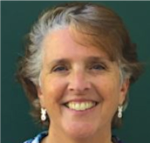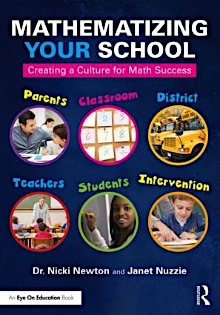Creating a Culture for Math Success
Mathematizing Your School: Creating a Culture for Math Success
By Dr. Nicki Newton and Janet Nuzzie
(Routledge/Eye On Education, 2019 – Learn more)
 Reviewed by Dena Hause
Reviewed by Dena Hause
After many years of teaching 5th grade language arts at our unique middle school (just 5th and 6th grade), this year I have the opportunity to teach math to 5th graders. I really enjoy math, and I’m excited about teaching math, but I’ve definitely been concerned about how to support students who struggle because they have the mindset that they are “bad at math.”
It’s been awhile since I taught math, and because I want my students to see themselves as being “good at math,” I was actively looking for professional books to refresh my memory about mathematics instruction, and to see if there are fresh ideas that I could build into my own practice for the upcoming school year.
A collaboration with teachers
 Mathematizing Your School is written by Nicki Newton and Janet Nuzzie, two math specialists; however this book is truly a collaboration between them and the classroom teachers they worked with in the Pasadena ISD in Texas.
Mathematizing Your School is written by Nicki Newton and Janet Nuzzie, two math specialists; however this book is truly a collaboration between them and the classroom teachers they worked with in the Pasadena ISD in Texas.
Together these educators collaborated to provide students with high quality math experiences and to support them in developing their confidence as mathematicians. The enthusiasm and the passion of these teachers shines through on every page of the book.
These educators describe mathematizing as “making math important.” In Mathematizing Your School the authors share the work of the Pasadena district leaders and school staff to develop a common mathematical language at the district, staff, campus, classroom and student level.
From PD to hands-on instruction
Each chapter provides a narrative of the work these teams engaged in. Initially, the work of the district was dedicated to providing professional development activities to help mathematics teachers work towards “developing a common language” and “building on shared knowledge.”
Subsequent chapters then elaborate on the specific instructional practices implemented at school sites – with staff, throughout school campuses, in specific classrooms, and with all students. Specific ideas for implementing the strategies are shared in each chapter, including examples and images of resources (anchor charts, bulletin boards, graphic organizers, lesson plan templates) developed and used by the authors and collaborators.
The chapters related to school sites are written directly by the classroom teachers and also include quotes from students sharing the impact they felt as a result of the mathematical work being done at their school sites.
I do recommend this book for both new and experienced math teachers, and I know there are ideas I read about that I will try to implement in my own classroom. This book could also be an effective book study for math departments, supported by the “Question to Consider” at the end of each chapter. I appreciated hearing directly from teachers, and I look forward to exploring the resources shared both within each chapter and the additional resources listed at the end of every chapter.
Drawbacks
I do have a con and a caveat. There was definitely a formula for each and every chapter that I think could have been simplified. For example, I did find the extensive biographies of the authors to be repetitive. All of the authors were introduced at the beginning of the book, but lengthier bios were also included at the start of each chapter they co-authored – and if they co-authored more than one chapter that bio was included (verbatim) again.
Another “heads up” is that the teachers in Pasadena had the support of mathematics resource teachers, and I’m not sure other teachers would have this kind of support which would make implementing some of the ideas an overwhelming challenge.
These things being said, I do feel that this book met my needs and will be a helpful resource for me as an experienced teacher who is “new again” to teaching math. If you’re putting together a small group of math resources, this is definitely a good choice,
Dena Hause (@sdteacher) has been teaching in San Diego for 35 years. This school year she is teaching 5th grade math and social studies at a 5th/6th grade middle school, but has experience teaching 5th grade language arts, 6th grade math, 5th and 6th grade social studies, and technology classes. Her degrees include a Master’s degree in Policy Studies and a second Master’s degree in Educational Leadership with a Focus on Technology.
































